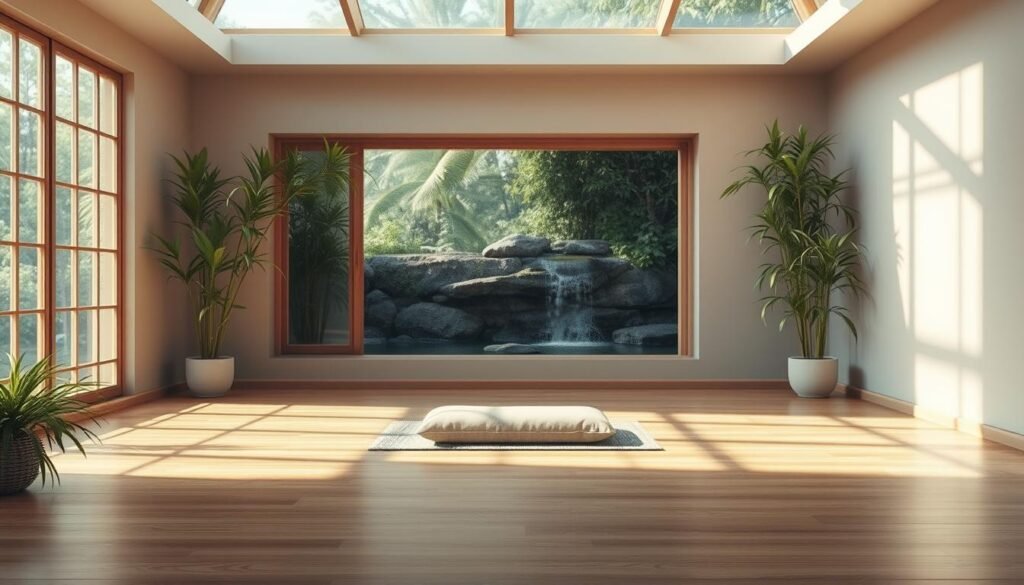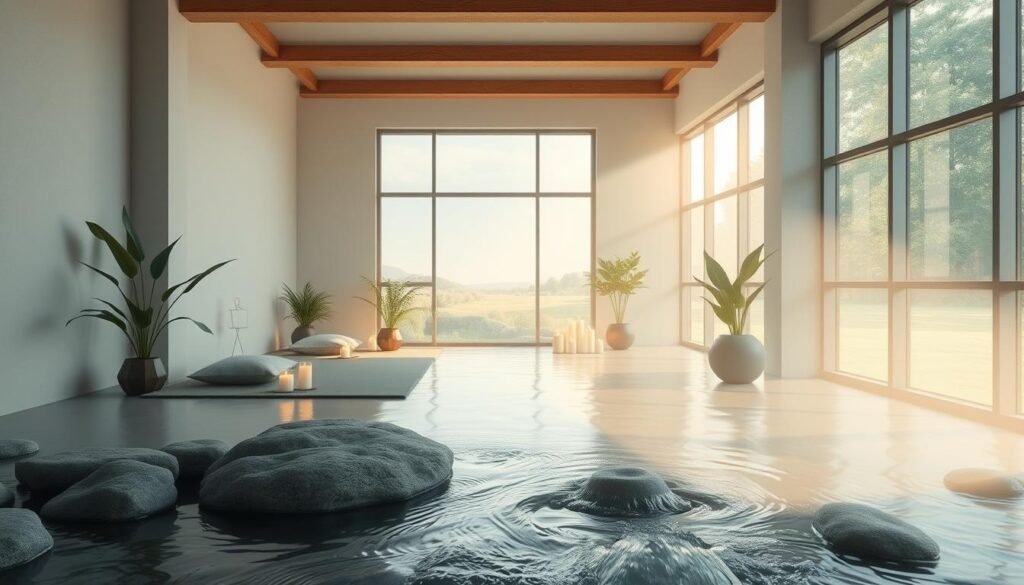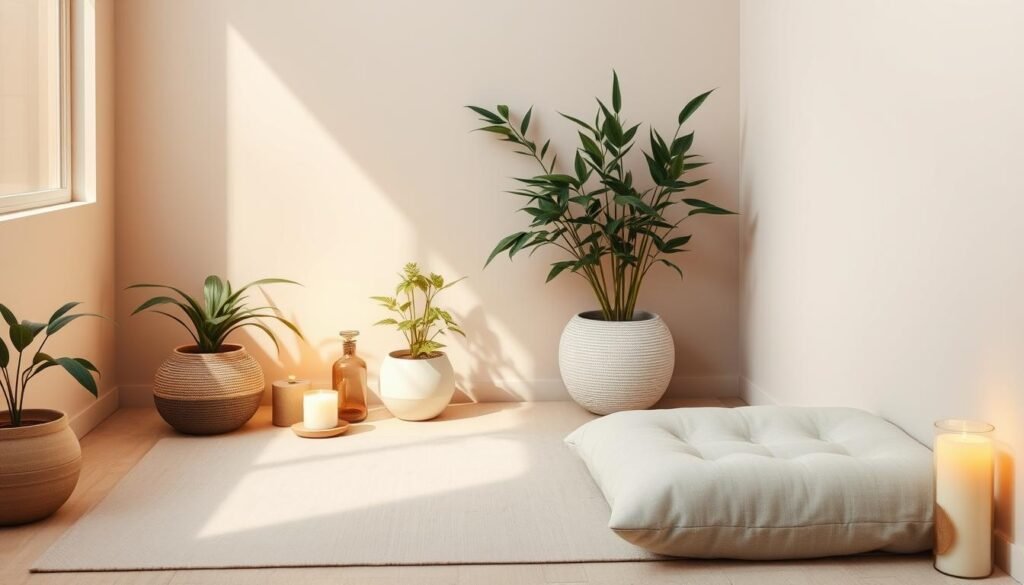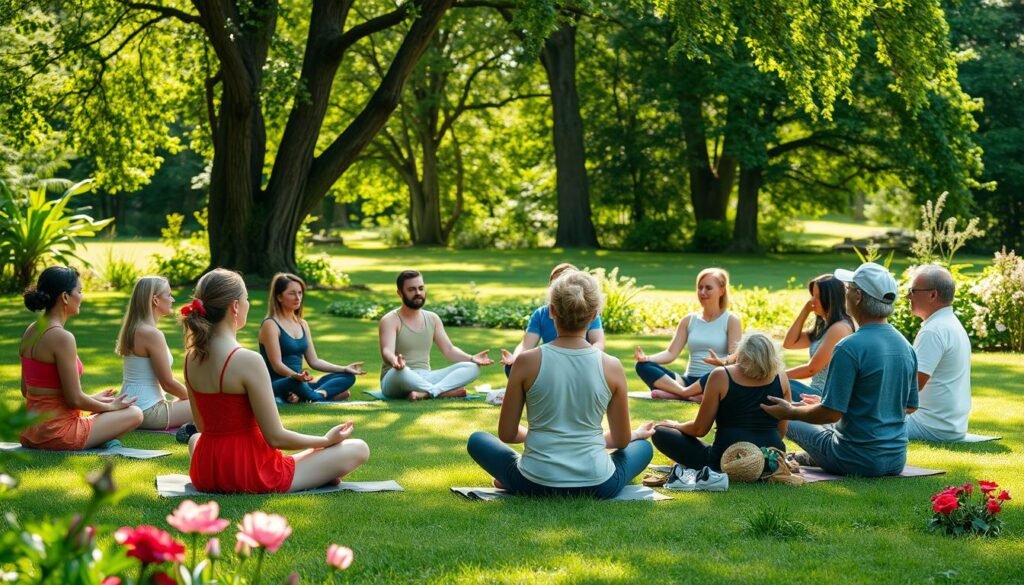Imagine a world where stress and anxiety melt away, replaced by a profound sense of inner peace and clarity. This is the transformative power of calm spaces meditation – a practice that has the potential to revolutionize your life. In this comprehensive article, we’ll guide you through the captivating world of mindfulness, exploring its profound impact on your mental, physical, and emotional well-being.
Calm spaces meditation is more than just a passing trend; it’s a time-tested technique that has been used for centuries to cultivate a deep connection with the present moment. By learning to quiet the incessant chatter of the mind and focus on your breath, you’ll unlock a profound sense of clarity and calm that can permeate every aspect of your life.
Whether you’re seeking relief from the demands of a fast-paced lifestyle, struggling with chronic stress, or simply yearning for a deeper sense of purpose, calm spaces meditation can be the key to unlocking a more fulfilling and balanced existence. Through this transformative practice, you’ll discover the power to cultivate a profound sense of inner peace, boost your mental focus, and improve your overall well-being.
Key Takeaways
- Discover the transformative power of calm spaces meditation and its impact on your mental, physical, and emotional well-being.
- Explore the science behind meditation and its effects on brain function, stress response, and overall health.
- Learn how to create the perfect meditation environment and develop a sustainable practice that fits seamlessly into your lifestyle.
- Incorporate mindfulness techniques into your daily routine to enhance your sense of presence and inner peace.
- Uncover advanced meditation practices that can deepen your experience and unlock new levels of consciousness.
Understanding the Power of Calm Spaces Meditation
Meditation has long been recognized as a powerful tool for stress relief, improving mindfulness practice, and promoting overall relaxation techniques. However, the true depth of its impact on the human mind and body is only now being fully understood through scientific research.
The Science Behind Meditation and Brain Function
Studies have shown that regular meditation can have a profound effect on brain structure and function. Neuroimaging research has revealed that the practice can increase the density of gray matter in areas associated with attention, emotional regulation, and self-awareness. Additionally, meditation has been linked to enhanced connectivity between different regions of the brain, improving overall cognitive performance and decision-making abilities.
How Meditation Affects Stress Response
Stress is a natural part of life, but prolonged exposure can have detrimental effects on our physical and mental well-being. Meditation has been demonstrated to regulate the body’s stress response system, reducing the production of cortisol, the primary stress hormone. By cultivating a state of calm and presence, meditation can effectively counteract the physiological and psychological impacts of stress, promoting a healthier and more balanced stress response.
Benefits for Mental and Physical Health
The benefits of meditation extend far beyond just stress relief. Consistent practice has been linked to a myriad of positive outcomes, including improved mindfulness practice, enhanced focus and concentration, reduced symptoms of anxiety and depression, better sleep quality, and even boosted immune function. By integrating relaxation techniques like meditation into our daily lives, we can unlock a path to greater overall well-being.
“Meditation is not just a tool for relaxation or focus – it’s a way of life that can transform our relationship with ourselves and the world around us.”
Creating Your Perfect Meditation Environment
Crafting the ideal meditation space is crucial for achieving a profound and transformative practice. Whether you’re seeking to cultivate zen spaces, tranquil environments, or simply establish a dedicated calm spaces meditation area, the right setting can significantly enhance your overall experience.
Start by identifying a quiet, secluded spot in your home or office that offers a sense of solitude and serenity. This could be a corner of your living room, a spare bedroom, or even a cozy nook in your workspace. The key is to choose a location that feels peaceful and free from distractions.
Lighting is another important element in creating the perfect meditation environment. Opt for soft, natural lighting, such as candlelight or dimmable lamps, to set the mood and promote relaxation. Avoid harsh overhead lighting or bright computer screens, as they can be stimulating and disrupt your focus.
- Incorporate soothing decor elements, such as plants, nature-inspired artwork, or a small water fountain, to further enhance the tranquil environments you’re cultivating.
- Consider adding comfortable seating, such as a meditation cushion or a low-to-the-ground chair, to support proper posture and alignment during your practice.
- Experiment with aromatherapy, using essential oils or incense, to create a calming sensory experience that promotes deeper relaxation.
Ultimately, the goal is to create a personalized zen spaces that resonates with your individual preferences and needs. By investing time and effort into crafting your perfect meditation environment, you’ll be setting the stage for a truly transformative calm spaces meditation experience.

Essential Elements of a Successful Meditation Practice
Cultivating a consistent and effective meditation routine is essential for achieving inner peace and personal growth. To unlock the full benefits of mindfulness practice, it’s crucial to understand the key elements that contribute to a successful meditation journey.
Proper Posture and Breathing Techniques
Proper body alignment and breath control are the foundation of a transformative meditation experience. Start by finding a comfortable seated position, with your spine straight and shoulders relaxed. Breathe deeply, focusing on the natural rhythm of your inhalations and exhalations. This mindful attention to your breath can immediately induce a sense of calm and clarity.
Time Management for Regular Practice
Consistency is key when it comes to meditation. Set aside a dedicated time each day, even if it’s just 10-15 minutes, to unwind and reconnect with your inner self. Experiment with different times of day to find the optimal window that fits your schedule and lifestyle. Establishing a regular practice will help you reap the long-term benefits of mindfulness practice.
Setting Realistic Meditation Goals
Begin your meditation journey by setting attainable goals that align with your personal needs and aspirations. These goals may include reducing stress, improving focus, or cultivating a deeper sense of inner peace. As you progress, adjust your goals to challenge yourself and track your growth. Celebrate your small victories along the way to stay motivated and inspired.
By mastering these essential elements, you’ll be well on your way to unlocking the transformative power of relaxation techniques and achieving a greater sense of balance and well-being in your life.

“The journey of a thousand miles begins with a single step.” – Lao Tzu
Incorporating Mindfulness into Daily Life
Mindfulness, the art of living in the present moment, holds the power to transform our daily lives. By weaving mindfulness practice into our routines, we can cultivate a profound sense of inner peace and stress relief. Discover the transformative potential of mindfulness as we explore practical strategies to integrate it seamlessly into your everyday activities.
Mindful Eating: Savor the Moment
Eating is often an automatic, hurried process, but by practicing mindful eating, we can reconnect with the joy of nourishing our bodies. Take a few moments to fully engage with your senses during meals – notice the aroma, texture, and flavors of your food. Slow down, chew thoroughly, and pay attention to the subtle sensations. This simple act can foster a deeper appreciation for the sustenance we consume and promote a healthier relationship with food.
Mindful Walking: Grounding in the Present
Walking is a natural part of our daily lives, but when infused with mindfulness, it becomes a powerful tool for anchoring ourselves in the here and now. As you move through your day, take a few minutes to be fully present with each step, feeling the connection between your feet and the ground. Observe your breath, the surrounding environment, and the sensations in your body. This mindful walking practice can provide a refreshing respite from the mental clutter and help you regain a sense of balance.
Mindful Work: Cultivating Focus and Awareness
In the hustle and bustle of our workdays, it’s easy to become lost in a flurry of tasks and deadlines. Incorporating mindfulness practice into your work environment can help you stay grounded and focused. Take periodic breaks to pause, take a few deep breaths, and bring your attention back to the present moment. When you return to your work, approach it with a renewed sense of clarity and purpose, allowing you to tackle challenges with greater efficiency and creativity.
By embracing these simple yet profound mindfulness techniques, you can weave inner peace and stress relief into the fabric of your daily life. Embark on this transformative journey and unlock the countless benefits of living with heightened awareness and presence.

| Mindfulness Practice | Benefits |
|---|---|
| Mindful Eating | Promotes a healthier relationship with food, enhances appreciation for nourishment |
| Mindful Walking | Anchors you in the present moment, provides a refreshing respite from mental clutter |
| Mindful Work | Improves focus, productivity, and creativity; fosters a sense of calm and purpose |
“The present moment is filled with joy and happiness. If you are attentive, you will see it.” – Thích Nhất Hạnh
Advanced Techniques for Deeper Meditation States
As you delve deeper into your meditation practice, there are several advanced techniques you can explore to unlock even more profound states of relaxation and self-awareness. Whether you’re seeking to enhance your calm spaces meditation or discover new relaxation techniques, these methods can help you tap into the full potential of your meditation journey.
Progressive Relaxation Methods
Progressive relaxation is a powerful technique that involves systematically tensing and then releasing different muscle groups throughout the body. This methodical approach allows you to achieve a deep state of physical and mental relaxation, paving the way for more focused meditation retreats. By consciously directing your attention to each muscle group, you can cultivate a heightened awareness of your body and its natural response to stress.
Visualization Practices
Visualization exercises can be a transformative addition to your meditation routine. By picturing calming, peaceful scenes or symbols, you can tap into the power of your imagination to induce a state of deep relaxation. Whether you envision a serene beach, a lush forest, or a symbolic representation of your inner self, these visualization practices can help you access profound levels of introspection and self-discovery.
Sound and Vibration Meditation
The use of sound and vibration can also be a potent tool in your calm spaces meditation arsenal. Techniques such as chanting, mantra recitation, and the incorporation of singing bowls or other resonant instruments can help you achieve a state of deep focus and inner calm. By tuning in to the rhythmic patterns and soothing tones, you can enter a meditative state that transcends the boundaries of the physical world.
Incorporating these advanced techniques into your regular practice can take your meditation experience to new heights, allowing you to access deeper levels of relaxation, self-awareness, and spiritual growth. Experiment with different methods and find the ones that resonate most with your personal relaxation techniques and goals.
Using Technology to Enhance Your Meditation Journey
In today’s digital age, technology has become a powerful tool for enhancing our meditation practice. From innovative meditation apps to immersive guided meditations, the world of digital wellness offers a wealth of resources to deepen our calm spaces meditation experience.
One of the standout features of meditation apps is their ability to provide personalized guidance and accountability. Meditation apps like Calm and Headspace offer a wide range of guided meditations tailored to different needs, whether you’re seeking stress relief, improved focus, or a deeper connection with your inner self.
| Meditation App | Key Features | User Rating |
|---|---|---|
| Calm | Wide selection of guided meditations, sleep stories, and mindfulness exercises | 4.8/5 |
| Headspace | Structured meditation programs, focus on mindfulness and mental health | 4.9/5 |
| Insight Timer | Diverse library of meditation apps and guided meditations, community features | 4.8/5 |
Beyond apps, the digital landscape also offers an array of calm spaces meditation resources, from soothing ambient soundtracks to immersive 360-degree video experiences. These tools can help create a deeply relaxing and focused environment, allowing us to fully immerse ourselves in the present moment.
“Technology can be a powerful ally in our meditation journey, but it’s important to maintain a balanced approach and not become overly dependent on digital tools.”
As with any aspect of our wellness routine, it’s crucial to find the right balance between technology and traditional meditation practices. By thoughtfully incorporating digital resources into our calm spaces meditation routine, we can unlock new levels of self-discovery and personal growth.

Creating Zen Spaces at Home and Work
In our fast-paced, technology-driven world, it’s crucial to carve out serene oases where we can find respite and center ourselves. By intentionally designing zen spaces in our homes and workplaces, we can cultivate tranquil environments that support our calm spaces meditation practice and overall well-being.
Design Elements for Tranquil Environments
When creating a zen-inspired space, focus on minimalist design principles and the strategic use of natural materials. Incorporate soothing colors, such as soft grays, blues, and greens, and opt for clean lines and uncluttered surfaces. Incorporate natural elements like plants, stones, or wood to connect with the earth’s calming energy.
Incorporating Natural Elements
- Bring in potted plants or fresh flowers to purify the air and add a touch of vibrant life.
- Position a small water feature, such as a tabletop fountain, to provide the gentle, meditative sounds of flowing water.
- Display natural crystals, geodes, or river rocks to harness the grounding power of minerals.
Maintaining Sacred Spaces
Once you’ve curated your perfect zen space, it’s essential to preserve its tranquility. Establish a regular cleaning and decluttering routine to maintain the space’s serenity. Avoid using the area for activities that could disrupt the peaceful atmosphere, such as work or extended conversations. Treat the space as a sacred sanctuary where you can reconnect with your inner calm.

“The ultimate measure of a man is not where he stands in moments of comfort and convenience, but where he stands at times of challenge and controversy.”
By intentionally designing zen spaces at home and in the office, you can create tranquil environments that support your calm spaces meditation practice and overall well-being. Remember, these sacred spaces are meant to be honored, respected, and maintained as havens of peace and mindfulness.
Overcoming Common Meditation Challenges
Embarking on a mindfulness practice can be a transformative journey, but it’s not without its challenges. As you delve deeper into the realm of meditation, you may encounter obstacles that test your dedication and resolve. Fear not, however, as these common hurdles can be overcome with the right strategies and a resilient spirit.
One of the primary challenges meditators face is restlessness. The mind, accustomed to constant stimulation, can rebel against the stillness and silence of meditation. To combat this, try incorporating gentle movements or breath-focused exercises into your practice. Gradually, you’ll train your mind to find comfort in the present moment.
Distractions, both internal and external, can also disrupt your stress relief journey. Whether it’s the allure of your smartphone or the endless to-do list in your head, learning to gently redirect your attention back to your breath or mantra can help you regain focus. Practicing in a dedicated, distraction-free space can also work wonders.
Maintaining motivation can be another stumbling block on the path to inner peace. When the initial excitement wears off, it’s easy to let your practice slide. Experiment with different meditation techniques, set achievable goals, and celebrate your small victories. Connecting with a supportive community can also provide the encouragement you need to stay consistent.
Remember, the journey of mindfulness practice is not a straight line. Embrace the ebb and flow, and trust that with patience and persistence, these challenges will gradually dissipate, allowing you to deepen your practice and reap the profound benefits of meditation.

“The greatest weapon against stress is our ability to choose one thought over another.”
Building a Community Through Shared Practice
Meditation is a deeply personal journey, but it can also be a powerful force for building community. By connecting with like-minded individuals who share a passion for mindfulness, you can deepen your own practice and tap into the transformative power of collective calm spaces meditation.
Finding Local Meditation Groups
Seek out meditation groups in your local area to find a supportive community of practitioners. These groups often gather regularly for guided meditation sessions, workshops, and social events. Joining a local group can help you establish a routine, learn from experienced meditators, and forge meaningful connections.
Online Communities and Resources
For those who prefer a more flexible or remote approach, the internet offers a wealth of online meditation communities and resources. Explore forums, social media groups, and online classes to connect with a global network of mindfulness enthusiasts. These digital spaces can be invaluable for sharing tips, asking questions, and finding inspiration for your meditation retreats and mindfulness practice.
Organizing Meditation Events
Take your community involvement a step further by organizing meditation events in your local area. This could include hosting calm spaces meditation workshops, leading group meditations, or coordinating meditation retreats. By bringing people together around the shared practice of mindfulness, you can foster a sense of togetherness and deepen your own understanding of the transformative power of meditation.
Whether you choose to connect with a local group or explore the wealth of online resources, building a community around your meditation practice can be a truly rewarding experience. Embrace the opportunity to learn, grow, and find support on your journey towards greater calm and clarity.

Conclusion
As we conclude our journey through the world of calm spaces meditation, we hope you’ve discovered the profound impact it can have on your life. From understanding the science behind its benefits to creating the perfect meditation environment, this article has provided you with the tools and insights needed to embark on a transformative path towards inner peace and stress relief.
Remember, the key to a successful meditation practice lies in consistency and patience. By incorporating mindfulness into your daily routine and exploring advanced techniques, you’ll unlock deeper states of relaxation and self-awareness. Embrace the challenges, celebrate your progress, and trust that the long-term rewards of a regular calm spaces meditation practice will enrich your life in ways you never imagined.
As you continue on this journey, remember that you are not alone. Seek out local meditation groups, join online communities, and surround yourself with like-minded individuals who can support and inspire you. Together, we can create a world where calm spaces meditation is not just a practice, but a way of life, leading to a more peaceful and harmonious existence for all.
FAQ
What is calm spaces meditation?
Calm spaces meditation refers to the practice of creating and utilizing dedicated, tranquil environments to enhance the meditation experience. This approach combines mindfulness techniques with the intentional design of peaceful, zen-inspired spaces that promote relaxation, focus, and inner peace.
What are the benefits of calm spaces meditation?
Practicing calm spaces meditation can provide numerous benefits, including reduced stress and anxiety, improved focus and concentration, better sleep quality, and an enhanced sense of overall well-being. By creating a personalized, soothing environment, meditators can deepen their practice and experience greater mental and physical health benefits.
How do I create the perfect meditation environment?
To create an ideal meditation environment, consider factors such as location, lighting, temperature, and the inclusion of calming elements like plants, natural materials, and soft textures. Experiment with different setups to find what works best for your personal preferences and meditation style.
What are some essential elements of a successful meditation practice?
Key elements of a successful meditation practice include proper posture and breathing techniques, consistent scheduling and time management, and setting achievable goals. Developing these foundational skills can help you build a sustainable, transformative meditation routine.
How can I incorporate mindfulness into my daily life?
Integrating mindfulness techniques into everyday activities, such as mindful eating, walking, or even working, can help you stay present and cultivate awareness throughout your day. Start small by focusing on single tasks or experiences and gradually expand your mindfulness practice.
What are some advanced meditation techniques I can explore?
For experienced meditators, techniques like progressive relaxation, visualization practices, and sound or vibration meditation can provide deeper states of focus and inner peace. Experiment with these more advanced methods to deepen your meditation practice and unlock new levels of self-discovery.
How can technology support my meditation journey?
Various meditation apps, guided meditation recordings, and online resources can be helpful tools for enhancing your practice. However, it’s important to maintain a balance and not become overly reliant on technology, as the core of meditation is about cultivating present-moment awareness and inner stillness.
What are some common meditation challenges, and how can I overcome them?
Common meditation challenges include restlessness, distractions, and lack of motivation. To overcome these obstacles, try incorporating different techniques, adjusting your environment, and being patient and compassionate with yourself as you build a consistent practice.
How can I connect with a community of meditators?
Connecting with local meditation groups, online communities, and attending meditation retreats or events can be a great way to build a supportive network of fellow practitioners. Sharing your practice with others can deepen your understanding and provide valuable insights and inspiration.

Hello, I’m Jimmy, founder of Jimmy Cozy Life. I’m here to help you create a home that feels warm, stylish, and balanced. With ideas for decor, celebrations, wellness, and DIY projects, my goal is to share practical tips and a bit of inspiration to make your space truly special.
Disclosure: This post contains affiliate links. If you click and make a purchase, we may receive a small commission at no extra cost to you. The content on this website was developed with assistance from AI.



